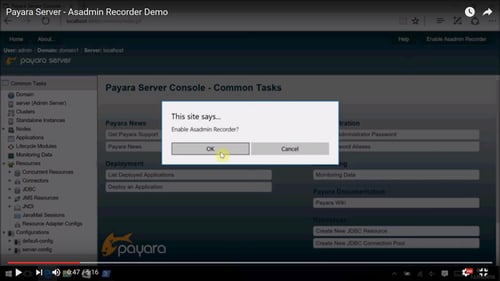Archive from May 2016
Piyara - Payara Micro on Raspberry Pi Demo
Published on 23 May 2016
by Steve Millidge
Topics:
Java EE,
Payara Micro,
Microservices
|
0 Comments
If you've read my interview with JAXenter, you already know that I very much disagree with labelling Java EE as heavyweight - simply because it is not true! The latest servers from most of the Java EE vendors have been re-architected to be very light-weight on resources including memory, cpu and disc footprint. We recently did some testing of microservices implementations and many of those come in at under 50MB of RAM to run Java EE based microservices. Also, installation and configuration has been streamlined and many of the microservices versions of the products require no installation.
Steve Millidge for JAXenter - 'Java EE’s heavyweight label is just mythology'
Published on 19 May 2016
by Dominika Tasarz
Topics:
Java EE,
Payara Micro,
Microservices
|
0 Comments
In this interview for JAXenter.com , Steve Millidge, the Founder of Payara and speaker at JAX 2016, talks about how to use CDI annotations in your Java EE applications, when to use which annotations, and what is automagically happening under the covers.
Steve also tells us exactly how heavyweight Java EE really is, explaining the repercussions and solutions.
JSF 2.3 - The WebSocket Quickstart under Payara Server
Published on 17 May 2016
by Dominika Tasarz
Topics:
Java EE,
How-to
|
4 Comments
Guest blog by Anghel Leonard ( @anghelleonard ).
Starting with JSF 2.3-m05 we can take advantage of a brand new feature - register a WebSocket push connection in client side. Thanks to the JSF team (especially to Bauke Scholtz (aka BalusC)) this feature is available in today milestone via <f:websocket/> tag.
In this post, let's see a minimal usage of <f:websocket/> tag.
Asadmin Recorder - New Payara Server Feature Demo
Published on 13 May 2016
by Andrew Pielage
Topics:
What's New,
Ops Teams,
How-to,
Admin,
DevOps
|
4 Comments
One of the most exciting new features in the Payara Server 162 release is the Asadmin Recorder - a tool especially useful for the Operations Teams!
Asadmin Recorder allows you to create runnable scripts of asadmin commands that mirror configuration done in the administration console. Have a look at our video walkthrough below for a quick overview of this new Payara Server feature.
Using Payara Server in Production - Guide
Published on 11 May 2016
by Steve Millidge
Topics:
Production Features,
Ops Teams,
DevOps
|
0 Comments
Once you have developed applications on Payara Server and moved these applications into a production environment, control will pass over to your Operations Teams. This guide will introduce some features of Payara Server that you may not know about, which are especially useful for the operations teams.
What's New in Payara Server 162?
Published on 06 May 2016
by Mike Croft
Topics:
What's New,
Payara Micro
|
7 Comments
The second release of 2016 is finally here! Payara Server 4.1.1.162 is our biggest release yet in terms of sheer number of bug fixes and new features. One of the biggest things isn't actually a new feature of Payara Server but a newly rehosted documentation, and it's where you'll find the full release notes for this version.
Introduction to Payara Scales - Using Payara Scales with Amazon CloudFormation
Published on 05 May 2016
by Mert Caliskan
Topics:
Hazelcast,
Clustering,
Scalability,
Cloud,
Amazon Cloud
|
2 Comments
In the first part of this 'Introduction to Payara Scales' blog, I will give you an overview of the architecture for a Payara Scales cluster and a load balancer upfront, using Amazon CloudFormation and Amazon EC2.






